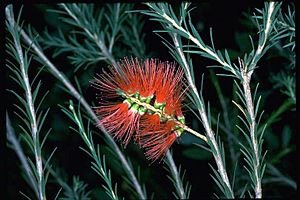Robin redbreast bush facts for kids
Quick facts for kids Robin redbreast bush |
|
|---|---|
 |
|
| Scientific classification | |
| Genus: |
Melaleuca
|
| Species: |
lateritia
|
The Robin Redbreast Bush (scientific name: Melaleuca lateritia) is a beautiful plant. It belongs to the myrtle family, called Myrtaceae. This plant grows naturally only in the southwest part of Western Australia.
Many people like to grow the Robin Redbreast Bush in their gardens. This is because it has lovely flowers that bloom for a long time. It can also grow well in many different weather conditions. It is a medium-sized bush, usually about 2 m (7 ft) to 2.5 m (8 ft) tall. It has rough, stringy bark.
Contents
What the Robin Redbreast Bush Looks Like
The Robin Redbreast Bush is an upright shrub. It can grow up to about 2.5 m (8 ft) tall and 3 m (10 ft) wide.
Its leaves are light green and thin. They are shaped like lines and are smooth. Each leaf is about 6 mm (0.2 in) to 25 mm (1 in) long. They are also about 1 mm (0.04 in) to 2 mm (0.08 in) wide. The leaves have a pointed tip. They grow in a spiral pattern around the stem.
The flowers are a bright orange-red color. They grow in spikes that can be up to 80 mm (3 in) long. These spikes are about 60 mm (2 in) across. The flowers grow on side branches from older parts of the plant. The stem keeps growing even after the flowers appear.
This bush flowers for a long time, from August to April. After the flowers, the plant makes woody fruits. These fruits are like small capsules, about 6 mm (0.2 in) to 8 mm (0.3 in) wide. They stay on the plant for many years. The seeds inside the fruits are not released right away.
How it Got its Name
The Robin Redbreast Bush was first officially described in 1859. A scientist named Albert Gottfried Dietrich gave it its scientific name, Melaleuca lateritia.
The second part of its name, lateritia, comes from a Latin word. It means "of bricks." This name was chosen because the flowers are a brick-red color.
Where the Robin Redbreast Bush Grows
The Robin Redbreast Bush grows in several areas of Western Australia. These areas include the Geraldton Sandplains and the Jarrah Forest. It also grows in the Swan Coastal Plain and the Warren region.
It likes to grow in sandy soil. You can often find it in swampy or wet places.
Is it Endangered?
The Robin Redbreast Bush is not considered to be in danger. The Government of Western Australia's Department of Parks and Wildlife lists it as "not threatened." This means there are plenty of these plants in the wild.
Growing Robin Redbreast Bush in Gardens
Many people grow the Robin Redbreast Bush in their gardens. It is a very popular plant for home gardens. Even though it naturally grows in areas with dry summers, it can also grow well where summers are wetter. This makes it a good choice for many parts of Australia.
It grows best in soil that drains water well. It also needs a sunny spot to thrive. If you prune it, you can help it keep a nice shape. Giving it fertilizer once a year, after it finishes flowering, also helps it grow strong.
Birds like honeyeaters love to visit the flowers. In Canberra, birds like the eastern spinebill and New Holland honeyeater often come to feed on its nectar.
Images for kids
-
M. lateritia growing in the Leeuwin-Naturaliste National Park



